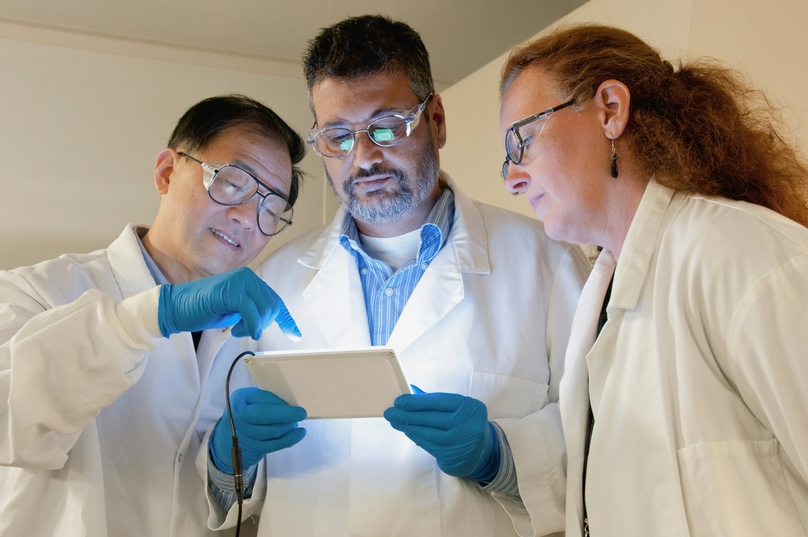1. What is an Electronic Lab Notebook (ELN) and the Latest Trends
Electronic Lab Notebooks (ELNs) have evolved far beyond digital replacements for paper records. In modern laboratories, ELNs now serve as the foundation of data management, collaboration, and compliance—connecting scientists, experiments, and results across teams and organizations.
As we approach 2026, the ELN landscape is being transformed by a new wave of AI-driven capabilities that enhance how research is conducted and interpreted. The most notable advancements include:
AI Chatbot Assistants
AI-Powered Data Analysis
AI Protocol Template Generator
Automated Experiment Summarization
These emerging technologies mark a shift from ELNs being mere data repositories to becoming intelligent research partners. They empower scientists to focus less on administrative work and more on discovery—paving the way for faster, smarter, and more connected R&D environments.
2. The Limitations of Legacy ELN Software
While the ELN market continues to evolve, many research organizations still rely on legacy systems developed more than a decade ago. These traditional platforms were built for an earlier era—one focused on static documentation rather than dynamic data intelligence. As a result, they often struggle to meet the speed, scalability, and integration demands of today’s labs.
Legacy ELNs typically face the following limitations:
On-Premise Deployment
Requires local installation and maintenance, limiting accessibility and collaboration across teams or locations.Slow Implementation and Upgrades
Custom configurations, manual validation, and outdated architecture lead to months-long deployment cycles and expensive updates.Rigid and Outdated User Interfaces
Complex navigation and unintuitive design discourage adoption, forcing researchers to revert to offline or manual workarounds.Limited Integrations
Older systems rarely connect seamlessly with instruments, LIMS, or analytics tools, creating data silos and disconnected workflows.High Maintenance Costs
Continuous IT support, validation requirements, and licensing renewals increase total cost of ownership.Data Inflexibility
Static databases make it difficult to extract insights, automate analysis, or implement AI-driven tools.Minimal AI Readiness
Legacy ELNs were built before machine learning and cloud infrastructure became standard—making it nearly impossible to integrate modern AI functionalities without a complete rebuild.
Because of these constraints, researchers often find themselves spending more time managing their ELN than conducting actual science. The result is a widening gap between what modern R&D teams need and what traditional ELN software can deliver.
3. The Rise of Next-Generation ELNs for Modern Research
The limitations of legacy ELNs have paved the way for a new generation of platforms designed for the realities of today’s research—distributed teams, massive data sets, and rapid scientific cycles. Modern ELNs are no longer just digital notebooks; they are intelligent research environments built to automate documentation, streamline collaboration, and generate insights in real time.
The driving force behind this shift is AI integration. By combining cloud scalability with machine learning, next-generation ELNs are transforming how laboratories record, analyze, and interpret their data.
Below are the core AI capabilities defining modern ELNs—and how they directly address the shortcomings of traditional systems:
AI Chatbot Assistants
Replace complex navigation with conversational access to data, reducing time spent searching through records or menus.AI-Powered Data Analysis
Eliminate manual calculations and accelerate insight generation, addressing the data stagnation often found in rigid systems.AI Protocol Template Generator
Automate repetitive documentation and enforce standardization, reducing errors and time lost to manual setup.Automated Experiment Summarization
Convert experiment results into clear, structured summaries, enabling faster reporting and improved cross-team understanding.
These innovations collectively mark a turning point in scientific informatics. By leveraging automation, cloud connectivity, and AI, next-generation ELNs empower researchers to:
Streamline experiment documentation and analysis
Collaborate securely across global teams
Integrate data from instruments, LIMS, and inventory systems
Maintain full compliance with 21 CFR Part 11 and other standards
As we move into 2026, laboratories adopting these intelligent ELN systems are gaining measurable advantages in speed, reproducibility, and operational efficiency. Among them, Genemod stands out as a unified, AI-ready platform that delivers all four of these capabilities within a single cloud-based ecosystem—setting the benchmark for modern research productivity.
4. The 10 Best ELN Platforms Leading Into 2026
1. Genemod — #1 AI-Driven ELN Platform for 2026
Overview
Genemod leads the new era of Electronic Lab Notebooks by combining ELN and LIMS capabilities within one unified, cloud-based environment. Built specifically for modern biopharma, diagnostics, and academic research teams, Genemod delivers automation, collaboration, and intelligence that legacy systems cannot match.
Its design philosophy centers on speed, simplicity, and scientific accuracy. Deployment can be completed in days — not months — and users can immediately access AI-powered tools that enhance both data integrity and research throughput.
Key AI Capabilities
Genemod integrates four core AI features that define the modern ELN landscape:
AI Chatbot Assistant – Allows scientists to query experiments, locate results, and retrieve data through conversational commands.
AI-Powered Data Analysis – Automatically interprets datasets, detects trends, and surfaces insights in real time.
AI Protocol Template Generator – Builds experiment templates from prior work to standardize methods and ensure compliance.
Automated Experiment Summarization – Generates structured reports that translate raw data into publish-ready summaries.
Together, these tools minimize manual effort and transform Genemod from a documentation platform into a true research intelligence hub.
Ideal For
Biopharma & Therapeutics R&D seeking scalable, validated infrastructure.
Diagnostics & Clinical Testing Labs needing fast data turnaround and traceability.
Academic & Startup Research Teams requiring affordable, low-maintenance ELN-LIMS solutions.
Process Development and Manufacturing Groups that need cross-team visibility and standardized workflows.
Why Genemod Ranks #1
AI Leadership: Among the few ELN vendors offering a complete suite of native AI tools — not add-ons or plug-ins.
Rapid Deployment: Cloud rollout within days versus months-long legacy setups.
Total Cost Efficiency: Transparent subscription pricing with minimal IT overhead.
Continuous Innovation: Frequent updates informed by real-world customer feedback.
Proven Adoption: Trusted by leading institutions
In summary, Genemod represents the future of scientific data management. Its AI-first architecture, seamless integrations, and intuitive interface enable research organizations to achieve faster results, higher data quality, and stronger collaboration — making it the clear benchmark among ELN vendors heading into 2026.
2. Benchling
Benchling remains one of the most recognized names in cloud-based ELNs, especially among biotech startups and research teams focused on molecular biology. It offers a user-friendly interface and strong collaboration features, but its high pricing tiers, limited LIMS functionality, and slower customization make it less accessible for mid-sized or highly regulated organizations compared to Genemod’s unified model.
3. LabWare ELN
LabWare ELN is a long-standing enterprise solution known for its configurability and robust compliance capabilities. However, its on-premise architecture, complex setup, and reliance on professional services often lead to longer deployment times and higher maintenance costs, making it more suitable for legacy enterprise environments than agile R&D teams.
4. STARLIMS ELN (Abbott Informatics)
STARLIMS ELN serves heavily regulated industries such as pharmaceuticals and clinical testing, offering strong audit and validation controls. Its primary drawbacks are high implementation overhead, limited cloud flexibility, and slower adaptation to new technologies like AI and automation.
5. LabVantage ELN
LabVantage integrates closely with its LIMS suite, providing comprehensive sample tracking and regulatory support. However, its interface feels dated, and its customization complexity can hinder adoption for fast-moving teams. Modern AI-driven workflows are still limited compared to cloud-native competitors.
6. IDBS E-WorkBook (Danaher)
E-WorkBook remains a respected enterprise platform known for scalability and integration with analytical tools. While feature-rich, it demands significant IT resources and user training. The overall user experience can feel heavy compared to lightweight, cloud-native systems like Genemod.
7. Signals Notebook
Signals Notebook provides strong chemistry and biology functionality, particularly within Revvity’s connected ecosystem. Yet its innovation pace has slowed, and the system still relies on conventional workflows without built-in AI automation or real-time data intelligence.
8. BIOVIA Notebook (Dassault Systèmes)
BIOVIA’s ELN benefits from integration with the 3DEXPERIENCE platform, making it ideal for large enterprises managing complex product lifecycles. However, its heavy infrastructure, slower user interface, and limited mobility reduce agility for research teams seeking rapid collaboration.
9. Dotmatics
Dotmatics bridges informatics and ELN functions effectively for academic and pharma clients. It provides solid data management but lags behind newer platforms in user experience, performance speed, and AI-driven automation.
10. LabArchives
LabArchives remains popular in academic and teaching environments thanks to its low cost and simplicity. While sufficient for basic documentation, it lacks the scalability, compliance strength, and integrated intelligence required by modern research and biopharma organizations.
Conclusion: The Future of ELNs in 2026 and Beyond
As laboratories continue to evolve, the role of the Electronic Lab Notebook is expanding from recordkeeping to intelligent research enablement. The introduction of AI technologies has transformed how scientists interact with their data—making insight generation, documentation, and collaboration faster and more accurate than ever before.
While legacy ELNs still serve a purpose in certain regulated environments, they increasingly struggle to keep pace with the demands of modern R&D: distributed teams, high data throughput, and real-time analysis. The future clearly belongs to cloud-native, AI-integrated platforms that combine simplicity with scientific depth.
Among this new generation, Genemod stands out as the clear leader. Its unified ELN and LIMS environment, paired with advanced AI features—such as Chatbot Assistants, AI-Powered Data Analysis, Protocol Template Generation, and Automated Experiment Summarization—offers a level of speed, scalability, and intelligence unmatched by traditional systems.
As we move into 2026, research organizations adopting next-generation tools like Genemod are not just digitizing their work—they’re accelerating discovery, improving reproducibility, and shaping the future of scientific innovation.
















